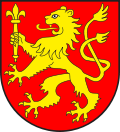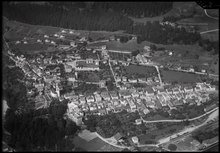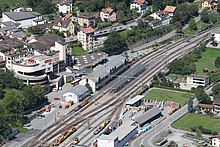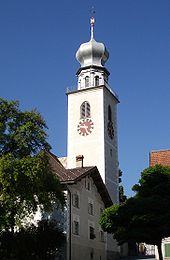Thusis
| Thusis | |
|---|---|
| State : |
|
| Canton : |
|
| Region : | Viamala |
| BFS no. : | 3668 |
| Postal code : | 7430 |
| UN / LOCODE : | CH THS |
| Coordinates : | 752 542 / 174 026 |
| Height : | 720 m above sea level M. |
| Height range : | 651–2400 m above sea level M. |
| Area : | 16.77 km² |
| Residents: | 3217 (December 31, 2018) |
| Population density : | 192 inhabitants per km² |
|
Proportion of foreigners : (residents without citizenship ) |
33% |
| Mayor : | Curdin Capaul |
| Website: | www.thusis.ch |
| Location of the municipality | |
Thusis ( Rhaeto-Romanic Tusáun , Italian Tosana ) is a political municipality in the Viamala region in the canton of Graubünden in Switzerland .
coat of arms
Blazon : In red is an upright golden lion with double tassel, in the right front paw a golden lily scepter reserved .
The coat of arms is based on the Heinzenberg court seal from 1584.
Before the lion there was a coat of arms with a person. This lion is depicted as a sculpture on the fountain in front of the town hall in Altdorfstrasse.
geography
The municipality of Thusis is located at the northern entrance to the Via Mala Gorge . The community borders the Heinzenberg in the west and the Hinterrhein and the Domleschg on the right bank of the Rhine to the east .
The Nolla , which rises on the northern flank of the Piz Beverin and flows into the Hinterrhein in Thusis, flows through Thusis .
history
Thusis was first mentioned in a document in 1156 ( curtim de Medezenu et Tosana ) and owes both its origin and its later development to the transit traffic to the San Bernardino Pass and the Splügen Pass . The foundation of Thusis is related to the construction and securing of the Rhine bridge, the development spurt with the relocation of the through road to the left bank of the Rhine and the expansion of the passage through the Via Mala Gorge from 1473 in order to counteract competition from other Alpine passes, as the obstacle was faced traffic was jammed in the gorge. The Via Mala was finally tamed by the construction of two bridges in 1738/39 and the relocation of dangerous parts of the road, as well as another relocation of the route from 1821 to 1823.
Over time, the stage destination Thusis with stables for 400 horses, restaurants and shops became more and more important. The importance can be measured by the fact that the funds for the reconstruction after the great fire of 1845 came from Zurich , Lindau , Ravensburg , Hamburg , Milan and Venice . When the Gotthard Railway began operating in 1882 , the Thusner transit traffic with carts and horses quickly lost its importance. In an effort to regain traffic, rail projects for the San Bernardino and Splügen Passes arose around 1900, and plans for a road tunnel under the San Bernardino in 1927, after the triumphant advance of the automobile. Due to the world wars and financial crises, it took until December 1, 1967, until the San Bernardino tunnel was opened as the first alpine national road tunnel in Switzerland. The upswing achieved as a result declined a little after the opening of the Gotthard road tunnel, but continues to this day.
In Thusis, at the beginning of the Bündner turmoil, the Thusner criminal court took place in 1618 .
On January 1, 2018, Thusis merged with the previously independent municipality of Mutten .
population
| Population development | |||||||||||||
|---|---|---|---|---|---|---|---|---|---|---|---|---|---|
| year | 1629 | 1850 | 1900 | 1950 | 1980 | 1990 | 2000 | 2005 | 2010 | 2012 | 2014 | 2016 | 2018 |
| Residents | 542 | 769 | 1281 | 1616 | 2525 | 2646 | 2717 | 2595 | 2791 | 2937 | 2994 | 3111 | 3213 |
Despite its function as a center for the communities of Heinzenberg, Thusis remained a small town with just under 700 inhabitants until the 19th century (1850: 769 inhabitants). Between 1850 and 1888 the population increased markedly to 1281 people (1850–1888: +67%). Thereafter, there was stagnation lasting for decades (1888–1930). From 1930 to 2000 the population grew again strongly, especially between 1941 and 1970 (1941–1970: +70%). The reasons for this are immigration from the surrounding villages and immigration from abroad. First came Italians and Spaniards, then Tamils from Sri Lanka and, after 1985, immigrants from Portugal and the republics of the former Yugoslavia.
languages
Thusis has long been a German-speaking community where Thusner German is spoken. The Graubünden Romanesque in the idiom Sutselvisch in Thusis gave way to German as early as the 16th century, whereas the neighboring communities were not Germanized until the 19th century.
| Languages in Thusis GR | ||||||
| languages | 1980 census | 1990 census | 2000 census | |||
| number | proportion of | number | proportion of | number | proportion of | |
| German | 1887 | 74.73% | 1995 | 75.40% | 2112 | 77.73% |
| Romansh | 238 | 9.43% | 136 | 5.14% | 107 | 3.94% |
| Italian | 230 | 9.11% | 172 | 6.50% | 129 | 4.75% |
| Residents | 2525 | 100% | 2646 | 100% | 2717 | 100% |
In the 2000 census, 78% stated German, 5% Serbian and 5% Italian as their main language. A total of 191 people (= 7%) still speak Romansh - including 126 together with German, 38 together with German and Italian and thirteen people all national languages.
Religions and denominations
The Reformation was introduced in Thusis as early as 1525. Due to the high level of immigration from other municipalities in Switzerland and abroad, the population is today very confessionally mixed. In the 2000 census, Protestants only had a relative majority of 1142 (42%) people. There are also 1085 (40%) Catholics (many of southern European origin) and 134 Orthodox (5%). The majority of adherents of non-Christian religions were Muslims (96 people; 3%) and Hindus of Tamil origin. The remainder consists of 101 (4%) non-denominational and 95 people with no denomination.
Origin and nationality
Of the 2595 residents at the end of 2005, 1991 (= 77%) were Swiss citizens. In the last census, 2034 (= 75%) Swiss - including 107 dual citizens - and 683 foreigners were counted. The largest groups of immigrants come from Serbia, Italy, Portugal, Germany, Croatia, Sri Lanka and Bosnia-Herzegovina. At the end of 2014, over 3,054 people lived in Thusis. With 1010 people, more than a third of the Thusners do not have a Swiss passport.
economy
Thusis has a central function for the entire valley including Heinzenberg and Domleschg as well as other catchment areas such as Schams and Albula valley . Commerce and industry are the main pillars of prosperity in the community. The number of farms, on the other hand, has fallen sharply. However, agriculture is still of great importance for the maintenance and care of the landscape. Thusis is also the location of the regional hospital, which is important for the aforementioned center function. Thusis is the editorial office of the regional newspaper , the Pörtli .
tourism
For several years, Thusis has been gaining ground thanks to its scenic surroundings such as the Domleschg, the Heinzenberg, with its extensive mountain meadows and farms, the Piz Beverin, the Hohenrätien and numerous world-class sights in the immediate vicinity (e.g. the Via Mala Gorge, The ceiling paintings of St Martin's Church in Zillis, the Carolingian church Mistail , the Albula line of the Rhaetian Railway , which is part of the world cultural heritage and starting point in Thusis, as well as the historical hiking trail Via Spluga , from Thusis over the Splügen Pass to Chiavenna (Italy)) are increasing tourist importance.
The Domleschg Castle Path ends in Thusis, which is also the starting point for the Veia Traversina and the Via Albula / Bernina .
For the time being, Thusis is almost only an overnight stop for group travelers and passers-by. For a holiday destination such as the health resorts of Lenzerheide or Davos , which can be quickly reached from Thusis, Thusis lacks the necessary tourist infrastructure. With the exception of two hotels and a campsite, there are hardly any overnight stays in Thusis for permanent guests. There are practically no holiday homes and apartments in Thusis.
traffic
Thusis is the starting point of the Albula line of the Rhaetian Railway to St. Moritz . The InterRegio Chur - Thusis - Samedan - St. Moritz and the S-Bahn line S2 to Chur, which starts in Thusis, run every hour .
From the PostBus bus station at the train station, several lines open up the surrounding communities on Heinzenberg and Domleschg. The PostBus express routes from Chur to Bellinzona via San Bernardino also stop here.
Thusis is connected to the motorway network with two junctions on the A13 .
Culture, sights
The Neudorf is particularly worth seeing (see picture). It was rebuilt after the great village fire of 1845, which destroyed large parts of today's old village. The Neudorf was built in a straight line along the main road running from north to south. The buildings, built in an elegant style influenced by nearby Italy, testify to the prosperity and self-confidence of the Thusner dignitaries of that time. Even today there are shops with a wide range of products and inns, which give the street its lively appearance, in most of the houses that are worthy of protection.
Also worth seeing in Thusis are the late Gothic Protestant church from 1506, the Rosenroll house from the 17th century, the baroque "Schlössli" from 1727 and the ruins of Obertagstein Castle high above Thusis, as well as the Hohen Rätien ruins in the neighboring municipality of Sils in Domleschg .
In the Viamala Gorge there are two architecturally interesting bridges from more recent times: Punt da Suransuns , 1999 and Second Traversine Footbridge , 2005, Architects: Jürg Conzett , Gianfranco Bronzini , Patrick Gartmann .
Personalities
- Hans Ardüser (1557 - after 1614), Graubünden painter, teacher and chronicler
- Annette Spiro (* 1957), architect
literature
- Erwin Poeschel : The art monuments of the canton of Graubünden III. The valley communities Räzünser Boden, Domleschg, Heinzenberg, Oberhalbstein, Upper and Lower Engadine. (= Art Monuments of Switzerland. Volume 11). Edited by the Society for Swiss Art History GSK. Bern 1940. DNB 760079625 .
- Jürg Simonett: Thusis. In: Historical Lexicon of Switzerland . 2005 .
Web links
- Thusis on the ETHorama platform
- Official website of the municipality of Thusis
- Hohen Rätien castle complex
Individual evidence
- ↑ Permanent and non-permanent resident population by year, canton, district, municipality, population type and gender (permanent resident population). In: bfs. admin.ch . Federal Statistical Office (FSO), August 31, 2019, accessed on December 22, 2019 .
- ↑ a b Andres Kristol: Thusis GR (Hinterrhein) in: Dictionnaire toponymique des communes suisses - Lexicon of Swiss municipality names - Dizionario toponomastico dei comuni svizzeri (DTS | LSG). Center de dialectologie, Université de Neuchâtel, Verlag Huber, Frauenfeld / Stuttgart / Vienna 2005, ISBN 3-7193-1308-5 and Éditions Payot, Lausanne 2005, ISBN 2-601-03336-3 , p. 874.
- ↑ domleschg24.ch ( Memento of the original from May 18, 2015 in the Internet Archive ) Info: The archive link was inserted automatically and has not yet been checked. Please check the original and archive link according to the instructions and then remove this notice.
- ↑ Schlössli
- ^ Viamala
- ↑ Punt da Suransuns
- ↑ Second traversine footbridge 2005










